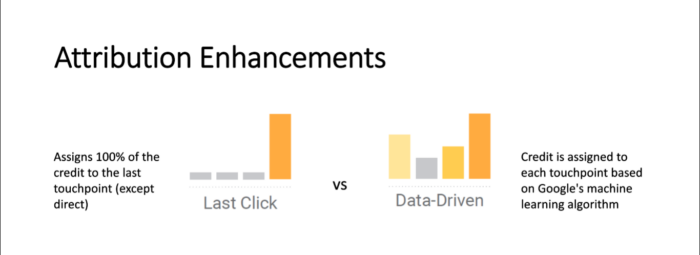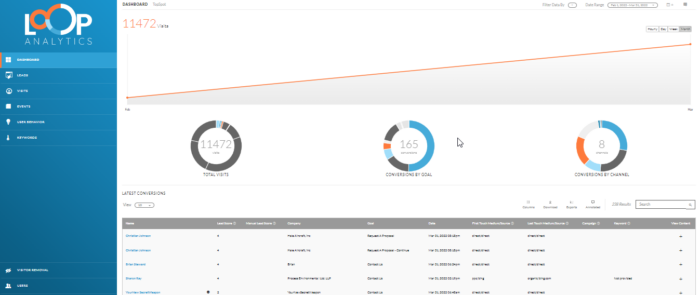January 11 2023
Digital Marketing Trends and Tool Changes 2023: Part 3
The Only Constant in Digital Marketing is Change
As we kick off a new year, we’ve reviewed the digital marketing trends and tool updates that will be top of mind as we strategize and plan for new and ongoing marketing initiatives. We began the series by exploring how user intent is essential to keeping search strategies effective in the wake of algorithm changes. Our second blog dove into search landscape changes and how critical website performance, content, and videos will be in claiming real estate. Now it’s time to discuss the biggest change Google has in store for search analytics.
“The” tool change of 2023 is the launch of Google Analytics 4 (GA4), happening July 1. This is an overhaul of a tool central to most marketing analytics efforts, meaning education and preparation is necessary to keep up as the industry moves forward. Additionally, we address several tools that can fill the data gaps GA4 presents. Finally, in this last blog of the series, we’ll talk about privacy and data changes that are constantly evolving thanks to lawmakers’ efforts. We’ll tell you what’s changing and how to prepare so you don’t risk penalties or loss of customer trust.

Don’t Panic—It’s Just Google Analytics 4
It’s the end of an era as Google launches the newest version of its analytics tool, the latest version having launched in 2012. Google Analytics 4 combines Universal Analytics (or GA3) with Google Analytics for Firebase (used for apps). Universal Analytics will sunset, and the historical data will be accessible for six months afterward. Data will not carry over from the old platform. To get ahead, TopSpot has been planning for the change since 2021 and was granted beta access to the tool. So far, we have updated over 80% of our Clients’ sites and will have all Clients fully migrated in Q1. We’ve been certifying our Teams and learning the ins and outs of the new platform to guide Clients through the transition.
Many are curious about what to expect from this change, and the biggest thing to brace yourself for is that data will never match one-to-one between the versions. That’s why Google recommends running the new and old versions in parallel. The difference in data is because “hit types” are handled differently. Universal Analytics hit types include page, event, e-commerce, and social interaction hits. Google Analytics 4 hit types are event-based, and it captures any interaction as an event. This means the possibility of conversion duplicates given the indiscriminate designation of hits—the tool counts every submitted form.
TopSpot recommends using custom event setups to help highlight those valued hits and can help set up those customizations as well as ensure the overall tracking setup is tailored to your needs. Our Team can additionally dig into each hit designation to better define user activity to strengthen your strategy. With our suite of tools, we can also help decipher those duplicates and remove any spam submitted.

But Wait—There’s More on GA4
Data-driven attribution is a big priority in GA4. Attribution Enhancements will be free to use now, unlike the previous version, and attributes credit for conversions. We’ll now see the first click (assigning 100% of the credit to the first touchpoint), the last click (assigning 100% of the credit to the last touchpoint), and credit attributions (assigning to each touchpoint based on Google’s machine learning algorithm).
While IP addresses are no longer logged, the tool has enhanced cross-device tracking and demographic information via Google Signals. Of course, major advances in machine learning and data modeling have been incorporated, plus predictive analysis that can help determine whether a user will churn or purchase. To learn more about GA4, check out our webinar introduction and check in for more in-depth content closer to launch.
While the GA4 changes may be daunting, it validates the need for a network of tools and a team of experts to ensure reporting is accurate. When things are hazy in the early days of GA4, we can look to other tools to clarify data. It needs to go beyond Google’s suite of products and offer points of view outside pre-conversion data. TopSpot has tools that provide insight into both pre- and post- conversion data.

Bridging the GA4 Gap
One out of three Fortune 500 companies will call versus submitting a form online. Not only can we get insight into how we get prospects to contact a company but can improve the post-conversion experience and apply learnings to future search strategies. By listening to sales conversations in CallRail, we can learn what a qualified lead looks like, what requirements they have, and get real-time sales data plus direct insight into how your team is doing post-conversion. A new feature coming to CallRail generates a summary of calls from the transcript, making it quicker to absorb the content of a call and utilize it in your search strategy by applying the intent noted by prospects.
Proprietary to TopSpot, Loop Analytics will integrate with CallRail this year, so now see all your forms and calls in one platform. We are streamlining this feature in staging to ensure we are not over-reporting leads due to spam and will move to beta testing soon. This integration will provide a deeper understanding of the user journey with pre-and post-conversion behavior and analyze lead quality to further refine strategies.
With so many tools, getting analytics with an integrated and personal approach is essential. TopSpot’s Analytics Team installs and customizes these tools, so if data is missing or is unclear in one tool, we can pull from Google’s tools or our own to bridge that gap. Our Customer Relationship Teams pull everything together for you in one unified report to develop a personalized strategy that considers the full customer journey.

Changes to Data Privacy and Cookies
Data privacy makes headlines constantly thanks to breaches, new technology, and the laws created to keep these two in check. Your business needs to stay compliant as new state laws appear, GDPR continues, and cookie policies change. The area of user consent doesn’t have a single answer, but there are many wrong answers. Best practices vary from business to business, but in general, anything going out globally should have an opt-in approach. For users in the European Union, an opt-in is required. Though not as strict as the EU, the US may not require opt-in, but it does require an opt-out.
California enacted the California Privacy Rights Act in 2020, and updates begin this year. Given the climate, other states will likely follow. While we are not lawyers, we take these laws very seriously and believe it’s the responsibility of those in digital marketing to keep up with these laws and collaborate with Clients to ensure strategies and implementations comply.
Pro Tip: Evaluate your privacy policy each year and personalize your cookie banner for your brand.
All cookies are not the same, and cookie consent continues to develop. First-party cookies get stored on websites you visit, collect analytics data, and remember settings. This data feeds our tools and is not going away, so we can continue to leverage this data. Third-party cookies are stored on a third-party website and track users across different websites to target advertising wherever that user goes. In an effort for a more privacy-focused internet, Google plans to stop using third-party cookies in Chrome by the end of 2024. The rollout will begin this year and will be gradual.
Google Analytics 4 also includes features to address privacy and data. There are now privacy controls built-in to the updated tool and regional controls for GDPR that process on EU servers. Again, IP addresses are not logged, so to fill the gaps in data from cookies that are blocked, machine learning and data modeling kick in.
Crack Down on Spam
The final update to discuss here is what Google has dubbed the “December 2022 Link Spam Update”. Your rankings may change as spam links are neutralized during this effort, ensuring no credit will pass to them. Again, it all goes back to a focus on trust and a crackdown on content written for SEO-only purposes, which is not helpful to users.
This update is leveraging Google’s SpamBrain, a machine learning system that improves search spam detection. While not a new system, Google claims it can now detect spam directly, finding sites buying links and sites used to pass outgoing links. SpamBrain is credited by Google for catching about six times more spam sites in 2021 than it did in 2020.
The goal is also to make search “spam free” and the system is said to have achieved this at a rate of 99%. Artificial intelligence is not perfect, so to ensure your site isn’t getting mistaken for spam, you need to have quality content based on user intent to populate the right search landscapes.
What’s Your Takeaway
Google’s intense interest in trust is creating massive shifts in digital marketing, for better or worse. While taking a trust fall into Google Analytics 4 still seems terrifying, bridging data gaps is the key to taking the plunge. It’s not a distrust of Google, but more assurance that you are getting the data you need to produce the right marketing and results.
With outside tools that can clarify data, find missing data, and reveal insights into both pre- and post-conversion, having a technical team on your side will make the era of GA4 far less painful. Plus, with the mounting data privacy rules and regulations, you need to ensure Google can trust you. Contact the Team at TopSpot to get help with your analytics and site content with an integrated strategy that addresses all the changes and updates coming up in 2023.
Tags: cookies, data privacy, google, google analytics, loop analytics
